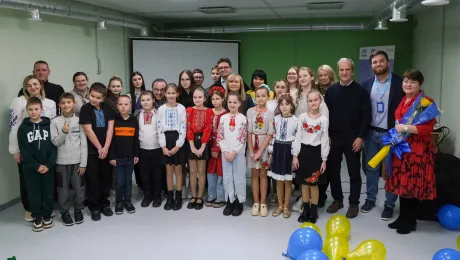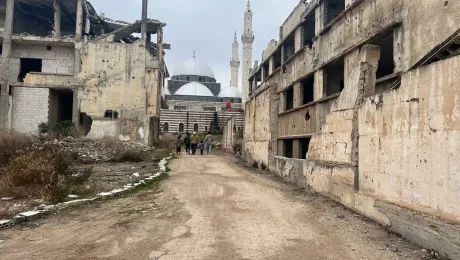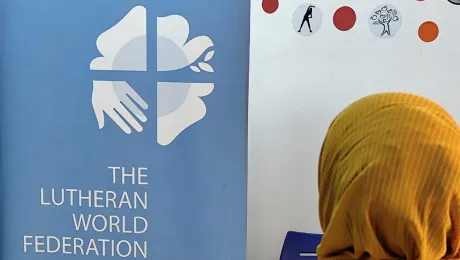Venezuela is in a challenging socioeconomic situation. Many people cannot afford essential services, such as water and health care, says LWF Global Humanitarian Coordinator Allan Calma after a recent visit to the country.
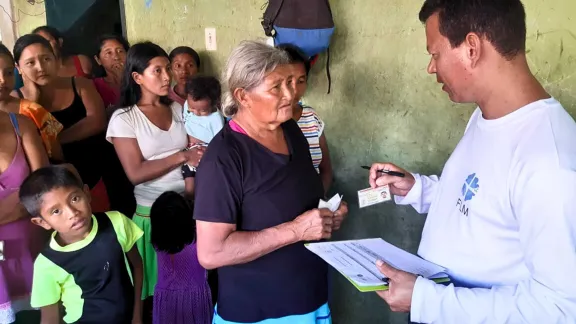
Humanitarian work in the indigenous communities of Pepeina, Wakajara de la Horqueta and Winamorena in the Municipality of Pedernales, Delta State - Venezuela. Photo: LWF Colombia-Venezuela
Interview with Allan Calma, LWF Global Humanitarian Coordinator
(LWI) - More than seven million Venezuelans have left their country. Political instability, economic hardship, and a lack of social services continue to drive people out of the country, despite some initial signs of some people returning.
The LWF country program in Colombia-Venezuela supports migrants traveling through Colombia and vulnerable communities in Venezuela and Colombia. Allan Calma, who coordinates humanitarian work in the LWF World Service headquarters in Geneva, recently visited the country. In this interview, he shares his impressions, talks about what's needed most and why there is still a reason to hope.
What were your impressions of Venezuela?
Venezuela is in a challenging socioeconomic situation. For some goods and services, the prices are as high as in Switzerland. At the same time, the salaries are not enough even to pay rent. I don't know how most people survive; one can't possibly support oneself with the wage they generally earn.
There are hardly any social services. You have to bring your own medicine and equipment when you need treatment at a public hospital. If you need surgery, you must go to a pharmacy and buy the medication and medical supplies (e.g., lancets and dressings) because the hospitals do not have them. Water is rationed; people only have water four days a week. On the other three days, they either use water they saved or buy more for a higher price. And this is the situation in the capital; you can imagine what that means for the rural areas.
Education is in a very bad state. We went to the rural areas in the Delta region; the schools are in terrible condition, so people use other buildings, for example, churches. Often, there are no teachers in places where there are schools because salaries are low and, in some cases, local administration has no budget for it. Some NGOs pay those salaries instead, but as we have seen in other humanitarian contexts, it's a slippery slope as this needs to be the sole responsibility of the government. The situation is challenging.
What is LWF doing in Venezuela?
In Venezuela, we are working in rural and urban areas, in places most affected by the crisis. Part of our work is supporting indigenous communities. They live by the river, in the delta, you can only get there by boat. Most indigenous families in the municipality of Pedernales in Delta do not have a fixed income; they only have a subsidy from the government, which is 10 dollars a month. The team tells us that the families there eat only once a day, and they cannot afford foods with protein, such as meat. A liter of water already costs 2.5 USD.
Together with the World Food Program (WFP), we provide school meals because school meals encourage attendance and can support better nutrition. At the same time, we also give food packs and water to the local community.
Among some in the international community, there is a general feeling that the migration crisis is over and people have returned to Venezuela, but it is not over. The migration crisis continues.
Allan CALMA, Global Humanitarian Coordinator
We also work with returnees. There are a lot of people who leave the country, but some started to return as they thought they saw signs of recovery. Among some in the international community, there is a general feeling that the migration crisis is over and people have returned to Venezuela, but it is not over. The migration crisis continues, and that continues to be a significant strain on the communities in Venezuela.
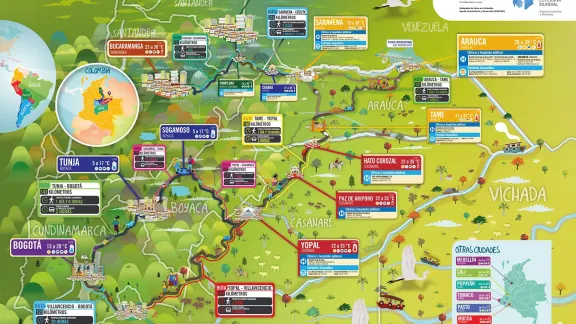
A map for the migrant population in transit on the Arauca Casanare protection route, developed by LWF Colombia in Venezuela with support from the Swiss Embassy. Photo: Lorena Acevedo, FLM Colombia y Venezuela
Does LWF also support people on the move in Colombia?
Yes, people leaving Venezuela must pass through other countries, including Colombia. They enter the country in Arauca, where we have been working for more than 20 years now. We are working along the main road from the border in Arauca to the Colombian capital, Bogotá. One of our projects is a map, which tells people where services are available. We give this sheet to all the refugees who come in so they know where they can go for which services. The map indicates the main road, how many days it takes to walk, and how many if you hitch a ride. You can see many families with cooking pans on their backs, and they are hitchhiking.
Multiple crises impact Colombia as it continues to deal with the refugees but also with its internal conflict as non-state armed groups (guerrilla) fight and try to claim space nationwide. Refugees face tensions with the host communities; they can get caught in conflict between non-state armed groups or attacked by gangs targeting refugees along the migration route. Criminals attack them, steal from them, and rape them – there is much crime happening in that region, and it's usually unreported.
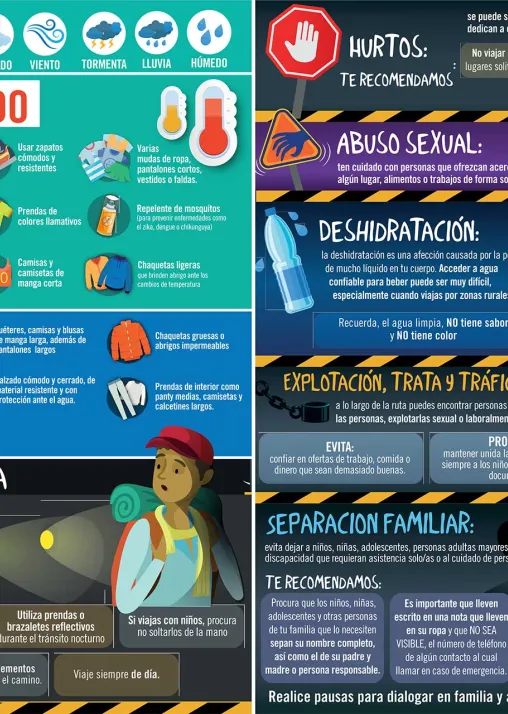
Instructions and risks of the route are depicted on the back side of a map designed for the migrant population in transit on the Arauca Casanare protection route, developed by LWF Colombia in Venezuela with support from the Swiss Embassy. Photo: Lorena Acevedo, FLM Colombia y Venezuela
Where do people want to go?
They want to stay in Venezuela if they can. There is just no opportunity for them, so unless we solve the issues in Venezuela, migration will continue. They go to Colombia and El Salvador first, but they are trying to go to the United States of America. The USA is the new desired destination for most Venezuelan migrants and refugees. More than half a million people, nearly two-thirds of Venezuelans, risk their lives crossing the Darién gap, a dangerous jungle between Colombia and Panama. Others make their way to the Atlantic Coast and embark on a perilous journey to reach the USA by sea.
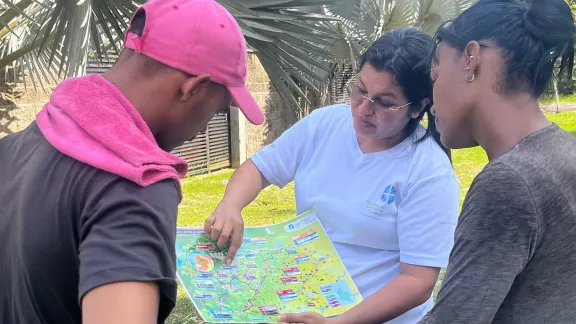
LWF staff explains where they can help to migrants from Venezuela. The map of the Arauca Casanare protection route was developed by LWF Colombia in Venezuela with support from the Swiss Embassy. Photo: LWF/ Lorena Acevedo
How are you collaborating with local LWF member churches?
We are working very closely with LWF member churches; collaboration is excellent. In Venezuela, we work through the Evangelical Lutheran Church in Venezuela; in Colombia, there's also significant collaboration on projects with the Evangelical Lutheran Church of Colombia. The church is for example present on the Atlantic coast, in Chocó, close to where the jungle and the sea route start.
Are there any hopeful signs?
Good Venezuelan professionals are returning, trying to see what they can do to help. There is a visible increase in the number of INGOs now being led by Venezuelans leaving their overseas postings to return home and work from there. I was inspired by the presence of young people and their passion and enthusiasm for doing something for their country. We see this with our staff, which is a very hopeful sign to me.
